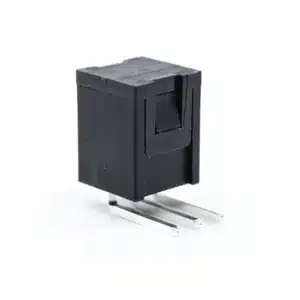What Is A Tilt Switch?
A tilt switch is a type of sensor that detects changes in its orientation or tilt. It is designed to open or close an electrical circuit based on the switch’s position. Tilt switches are simple devices that are often used to trigger actions in response to changes in an object’s position or orientation.
How Do They Work?
Tilt switches come in various forms, but they typically consist of a small metal or mercury-filled capsule mounted inside a housing. When the switch is tilted or the orientation changes, the metal or mercury inside the capsule moves and makes or breaks an electrical connection, thus altering the state of the switch.
E-Switch Tilt Switch Products
The TM1000 Series from E-Switch is environmentally friendly and contains no mercury. It’s triggered when tilted 45 degrees.

Pros & Cons Of Tilt Switches
Tilt switches are known for their simplicity and reliability (the TM1000 has a 1,000,000-cycle life expectancy), making them suitable for a wide range of applications that require the detection of changes in orientation or position. However, they may not be as precise or sensitive as some other types of sensors, such as accelerometers, which can provide more detailed information about the degree of tilt and movement in multiple directions.
What Are Tilt Switches Used For?
- Security Systems: They can be used in security systems to detect when doors, windows or panels are opened or tampered with. When the object to which the switch is attached tilts or moves, it triggers an alarm.
- Automotive Safety: In vehicles, tilt switches are used to deploy airbags in the event of a rollover or collision by detecting changes in the car’s orientation.
- Electronic Toys: Some toys use tilt switches to trigger specific sounds or actions when the toy is moved or tilted.
- Industrial Equipment: They can be used in industrial applications to monitor the position of equipment or machinery, ensuring safe operation.
- Game Controllers: They are commonly found in game controllers, such as those used in motion-sensitive video games. They can detect the orientation of the controller and translate it into in-game actions.
- Consumer Electronics: Some smartphones and tablets incorporate tilt switches to adjust the display orientation (from portrait to landscape mode) based on how the device is held.
